全英初中英语说课
初中英语全英说课稿优秀8篇
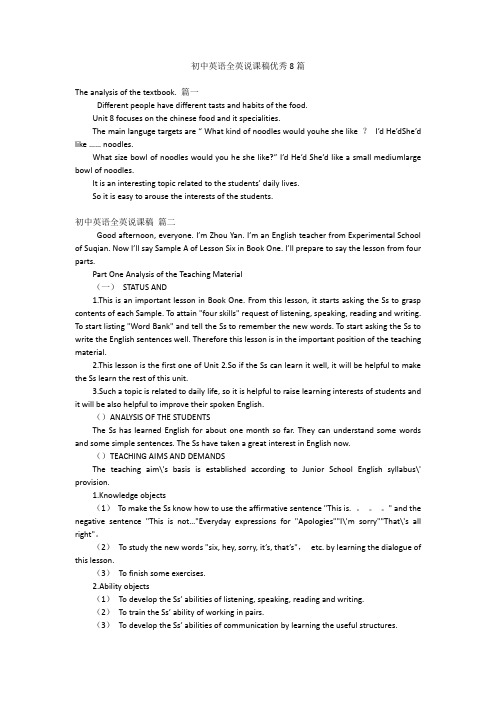
初中英语全英说课稿优秀8篇The analysis of the textbook. 篇一Different people have different tasts and habits of the food.Unit 8 focuses on the chinese food and it specialities.The main languge targets are “ What kind of noodles would youhe she like ?I’d He’dShe’d like …… noodles.What size bowl of noodles would you he she like?” I’d He’d She’d like a small mediumlarge bowl of noodles.It is an interesting topic related to the students’ daily lives.So it is easy to arouse the interests of the students.初中英语全英说课稿篇二Good afternoon, everyone. I’m Zhou Yan. I’m an English teacher from Experimental School of Suqian. Now I’ll say Sample A of Lesson Six in Book One. I’ll prepare to say the lesson from four parts.Part One Analysis of the Teaching Material(一)STATUS AND1.This is an important lesson in Book One. From this lesson, it starts asking the Ss to grasp contents of each Sample. To attain "four skills" request of listening, speaking, reading and writing. To start listing "Word Bank" and tell the Ss to remember the new words. To start asking the Ss to write the English sentences well. Therefore this lesson is in the important position of the teaching material.2.This lesson is the first one of Unit 2.So if the Ss can learn it well, it will be helpful to make the Ss learn the rest of this unit.3.Such a topic is related to daily life, so it is helpful to raise learning interests of students and it will be also helpful to improve their spoken English.()ANALYSIS OF THE STUDENTSThe Ss has learned English for about one month so far. They can understand some words and some simple sentences. The Ss have taken a great interest in English now.()TEACHING AIMS AND DEMANDSThe teaching aim\'s basis is established according to Junior School English syllabus\' provision.1.Knowledge objects(1)To make the Ss know how to use the affirmative sentence "This is. 。
全英初中说课稿
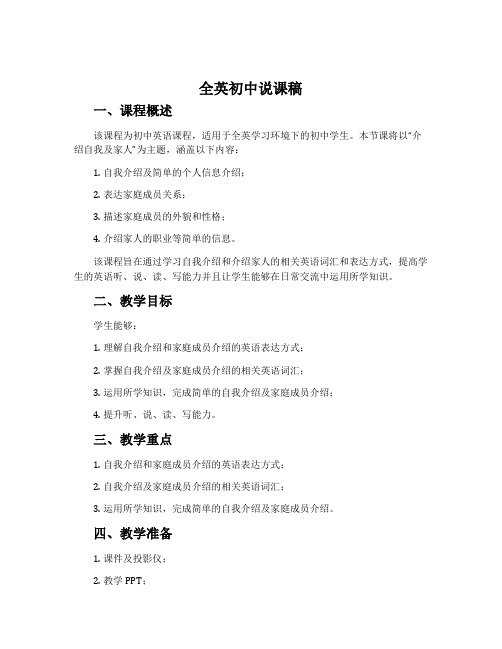
全英初中说课稿一、课程概述该课程为初中英语课程,适用于全英学习环境下的初中学生。
本节课将以“介绍自我及家人”为主题,涵盖以下内容:1.自我介绍及简单的个人信息介绍;2.表达家庭成员关系;3.描述家庭成员的外貌和性格;4.介绍家人的职业等简单的信息。
该课程旨在通过学习自我介绍和介绍家人的相关英语词汇和表达方式,提高学生的英语听、说、读、写能力并且让学生能够在日常交流中运用所学知识。
二、教学目标学生能够:1.理解自我介绍和家庭成员介绍的英语表达方式;2.掌握自我介绍及家庭成员介绍的相关英语词汇;3.运用所学知识,完成简单的自我介绍及家庭成员介绍;4.提升听、说、读、写能力。
三、教学重点1.自我介绍和家庭成员介绍的英语表达方式;2.自我介绍及家庭成员介绍的相关英语词汇;3.运用所学知识,完成简单的自我介绍及家庭成员介绍。
四、教学准备1.课件及投影仪;2.教学PPT;3.白板和笔等;4.学生练习用的英语词汇卡片。
五、教学过程第一步:导入新知识引导学生回忆上学期学过的自我介绍内容和和家庭成员介绍内容,然后告诉学生本次课程我们会一起学习如何用英语表达自我介绍及介绍家人。
第二步:讲解新知识导入新知识后,老师将通过课件和教学PPT介绍英语中描述外貌和性格方面的词汇。
例如:hair(头发)、eyes(眼睛)、face(脸)等等。
然后,老师将以图片等形式,向学生展示外国人常用的自我介绍方式,介绍英语中对于介绍家庭成员职业等信息的表达方式。
第三步:完成练习在学习新知识后,老师将通过练习让学生掌握并巩固新学的知识。
练习过程中,学生将通过使用卡片上分类好的英语词汇,完成自我和家庭成员的描述。
老师会对学生的发音和英语语法进行指导。
第四步:展示才艺最后,老师将邀请一些学生展示自己的才艺,例如:口语表达、词汇积累和听力等等。
六、教学评估1.通过互动讨论,单人和小组练习等形式,检测学生在英语听、说、读和写方面的掌握程度,评估他们取得的进步;2.观察学生在展示才艺时表现的口语和语法的准确性,评估学生在英语方面的表达能力。
初中英语全英说课稿
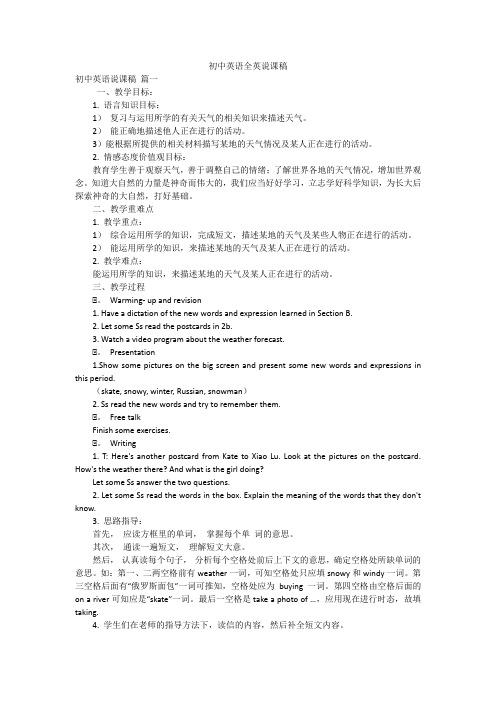
初中英语全英说课稿初中英语说课稿篇一一、教学目标:1. 语言知识目标:1)复习与运用所学的有关天气的相关知识来描述天气。
2)能正确地描述他人正在进行的活动。
3)能根据所提供的相关材料描写某地的天气情况及某人正在进行的活动。
2. 情感态度价值观目标:教育学生善于观察天气,善于调整自己的情绪;了解世界各地的天气情况,增加世界观念。
知道大自然的力量是神奇而伟大的,我们应当好好学习,立志学好科学知识,为长大后探索神奇的大自然,打好基础。
二、教学重难点1. 教学重点:1)综合运用所学的知识,完成短文,描述某地的天气及某些人物正在进行的活动。
2)能运用所学的知识,来描述某地的天气及某人正在进行的活动。
2. 教学难点:能运用所学的知识,来描述某地的天气及某人正在进行的活动。
三、教学过程Ⅰ。
Warming- up and revision1. Have a dictation of the new words and expression learned in Section B.2. Let some Ss read the postcards in 2b.3. Watch a video program about the weather forecast.Ⅰ。
Presentation1.Show some pictures on the big screen and present some new words and expressions in this period.(skate, snowy, winter, Russian, snowman)2. Ss read the new words and try to remember them.Ⅰ。
Free talkFinish some exercises.Ⅰ。
Writing1. T: Here's another postcard from Kate to Xiao Lu. Look at the pictures on the postcard. How's the weather there? And what is the girl doing?Let some Ss answer the two questions.2. Let some Ss read the words in the box. Explain the meaning of the words that they don't know.3. 思路指导:首先,应读方框里的单词,掌握每个单词的意思。
初中英语全英说课稿范文
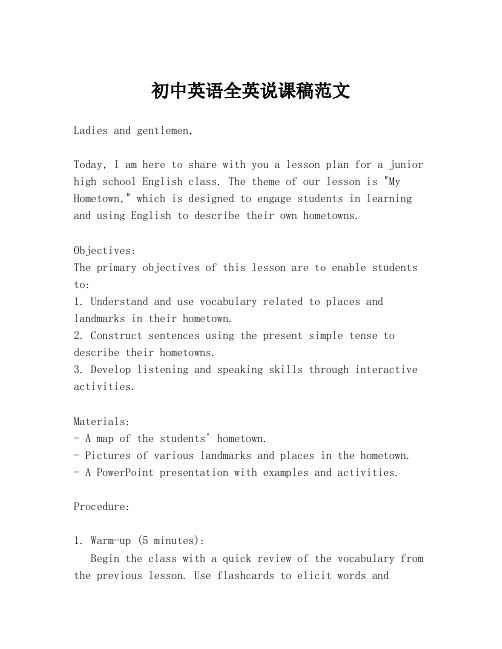
初中英语全英说课稿范文Ladies and gentlemen,Today, I am here to share with you a lesson plan for a junior high school English class. The theme of our lesson is "My Hometown," which is designed to engage students in learning and using English to describe their own hometowns.Objectives:The primary objectives of this lesson are to enable students to:1. Understand and use vocabulary related to places and landmarks in their hometown.2. Construct sentences using the present simple tense to describe their hometowns.3. Develop listening and speaking skills through interactive activities.Materials:- A map of the students' hometown.- Pictures of various landmarks and places in the hometown. - A PowerPoint presentation with examples and activities.Procedure:1. Warm-up (5 minutes):Begin the class with a quick review of the vocabulary from the previous lesson. Use flashcards to elicit words andphrases related to places and landmarks.2. Introduction (10 minutes):Show the students a map of their hometown and ask them to identify different places. Introduce new vocabulary such as "river," "park," "museum," and "historical site."3. Presentation (15 minutes):Use the PowerPoint to present sentences describing various places in a typical hometown. For example, "There is a beautiful park in the center of the city," or "The museum is located near the river."4. Practice (20 minutes):In pairs, students will take turns describing their hometown using the vocabulary and sentence structures introduced. Encourage them to use the present simple tense and to be creative with their descriptions.5. Listening Activity (10 minutes):Play a short audio clip describing a fictional hometown. After listening, students will answer comprehension questions in pairs.6. Group Work (15 minutes):Divide the class into small groups. Each group will create a poster of their hometown, including pictures and descriptions. They will then present their hometown to the class.7. Feedback and Correction (5 minutes):As the groups present, provide feedback on their use of language and encourage the class to correct any mistakes they notice.8. Wrap-up (5 minutes):Conclude the lesson by summarizing the key points and encouraging students to continue practicing their English by describing their hometowns to family and friends.Assessment:Students will be assessed on their participation in class activities, their ability to use the target language accurately, and their contributions to the group project.Differentiation:For advanced students, provide more complex sentences to construct and encourage them to use more sophisticated vocabulary. For struggling students, offer additional support and simpler sentence structures.Reflection:After the lesson, reflect on the effectiveness of the activities and consider any adjustments needed for future lessons to better meet the needs of all students.This concludes the lesson plan for "My Hometown." Thank you for your attention.。
初中英语全英文说课稿
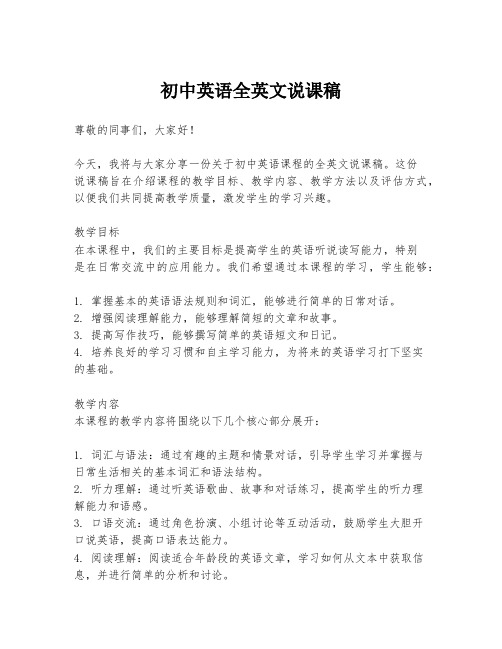
初中英语全英文说课稿尊敬的同事们,大家好!今天,我将与大家分享一份关于初中英语课程的全英文说课稿。
这份说课稿旨在介绍课程的教学目标、教学内容、教学方法以及评估方式,以便我们共同提高教学质量,激发学生的学习兴趣。
教学目标在本课程中,我们的主要目标是提高学生的英语听说读写能力,特别是在日常交流中的应用能力。
我们希望通过本课程的学习,学生能够:1. 掌握基本的英语语法规则和词汇,能够进行简单的日常对话。
2. 增强阅读理解能力,能够理解简短的文章和故事。
3. 提高写作技巧,能够撰写简单的英语短文和日记。
4. 培养良好的学习习惯和自主学习能力,为将来的英语学习打下坚实的基础。
教学内容本课程的教学内容将围绕以下几个核心部分展开:1. 词汇与语法:通过有趣的主题和情景对话,引导学生学习并掌握与日常生活相关的基本词汇和语法结构。
2. 听力理解:通过听英语歌曲、故事和对话练习,提高学生的听力理解能力和语感。
3. 口语交流:通过角色扮演、小组讨论等互动活动,鼓励学生大胆开口说英语,提高口语表达能力。
4. 阅读理解:阅读适合年龄段的英语文章,学习如何从文本中获取信息,并进行简单的分析和讨论。
5. 写作技巧:通过写作练习,如写日记、书信和短文,帮助学生提高写作组织能力和表达能力。
教学方法为了实现上述教学目标,我们将采用以下教学方法:1. 互动式教学:通过小组合作和角色扮演等活动,让学生在实际交流中学习和使用英语。
2. 多媒体辅助:利用视频、音频和图片等多媒体资源,使课堂内容更加生动有趣。
3. 任务型教学:设计贴近学生生活的任务,如购物、旅游等情景模拟,让学生在完成任务的过程中学习英语。
4. 个性化指导:针对学生的不同需求和水平,提供个性化的辅导和支持。
评估方式为了全面了解学生的学习进度和效果,我们将采取以下评估方式:1. 课堂表现:观察学生在课堂上的参与度和互动情况,评估他们的学习态度和口语表达能力。
2. 作业与练习:定期布置作业和练习,检查学生对课堂内容的掌握情况和自主学习能力。
初中英语全英说课稿优秀9篇
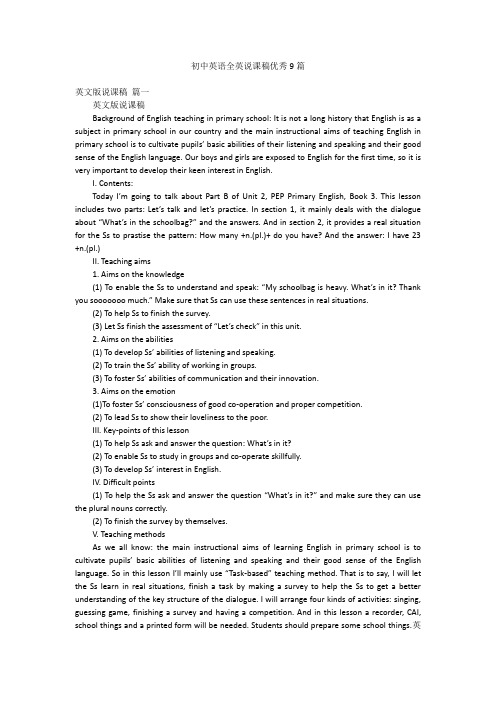
初中英语全英说课稿优秀9篇英文版说课稿篇一英文版说课稿Background of English teaching in primary school: It is not a long history that English is as a subject in primary school in our country and the main instructional aims of teaching English in primary school is to cultivate pupils’ basic abilities of their listening and speaking and their good sense of the English language. Our boys and girls are exposed to English for the first time, so it is very important to develop their keen interest in English.I. Contents:Today I’m going to talk about Part B of Unit 2, PEP Primary English, Book 3. This lesson includes two parts: Let’s talk and let’s practice. In section 1, it mainly deals with the dialogue about “What’s in the schoolbag?” and the answers. And in section 2, it provides a real situation for the Ss to prastise the pattern: How many +n.(pl.)+ do you have? And the answer: I have 23 +n.(pl.)II. Teaching aims1. Aims on the knowledge(1) To enable the Ss to understand and speak: “My schoolbag is heavy. What’s in it? Thank you sooooooo much.” Make sure that Ss can use these sentences in real situations.(2) To help Ss to finish the survey.(3) Let Ss finish the assessment of “Let’s check” in this unit.2. Aims on the abilities(1) To develop Ss’ abilities of listening and speaking.(2) To train the Ss’ ability of working in groups.(3) To foster Ss’ abilities of communication and their innovation.3. Aims on the emotion(1)To foster Ss’ consciousness of good co-operation and proper competition.(2) To lead Ss to show their loveliness to the poor.III. Key-points of this lesson(1) To help Ss ask and answer the question: What’s in it?(2) To enable Ss to study in groups and co-operate skillfully.(3) To develop Ss’ interest in English.IV. Difficult points(1) To help the Ss ask and answer the question “What’s in it?” and make sure they can use the plural nouns correctly.(2) To finish the survey by themselves.V. Teaching methodsAs we all know: the main instructional aims of learning English in primary school is to cultivate pupils’ basic abilities of listening and speaking and their good sense of the English language. So in this lesson I’ll mainly use “Task-based” teaching method. That is to say, I will let the Ss learn in real situations, finish a task by making a survey to help the Ss to get a better understanding of the key structure of the dialogue. I will arrange four kinds of activities: singing, guessing game, finishing a survey and having a competition. And in this lesson a recorder, CAI, school things and a printed form will be needed. Students should prepare some school things.英文版英语说课稿VI. Teaching procedures and purposes of my designing.I’ll finish this lesson in five steps.Step 1. Warm-up and preview1. Free talk between T and Ss about things in the classroom.2. Sing the song together: Books and pencils.3. Do some TPR, for example: Show me your English book. Show me your crayon.4. Review the numbers by asking: “How many crayons do you have?”Purpose: It is important to form a better English learning surrounding for the Ss by singing and doing some total physical response and at the same time it provides situations to review learned knowledge for the next step.Step 2. PresentationNow I’ll mainly talk about this step.1. Present the pattern: “My schoolbag is heavy.” “What’s in it?.”(1) Show a bag and say: “Look! I have a bag.” Carry it and say: “Oh, it is heavy. My schoolbag is heavy.” Help the Ss understand the meaning with the help of my body language. Then lead the Ss to read the sentence. Make sure they can say it correctly.(2) T: My schoolbag is heavy.Open the bag and say: “What’s in it? What’s in my schoolbag?”Take out a Chinese book. Then do the action again. Let the Ss read the sentence.2. Play a guessing game. Divide the whole class into four groups to have a competition.Let them guess: What’s in the bag? How many? Purpose: To present the key structures one by one is much easier for the Ss to learn and grasp the meanings. Proper competition can arouse the Ss’ interest in English learning.3. With the help of the CAI to present the dialogue. Set a situation to help Ss understand: Two Ss are coming. One girl is carrying a heavy bag on her back. They are talking.Girl: My schoolbag is heavy.Boy: What’s in it?Girl: 20 story-books, 32 pencil, 9 rulers, 12 crayons and 30 picture-books. Etc.Boy: What will you do?Girl: They are for the poor.Boy: Great! I’ll bring some school things too.The boy comes back home and puts a lot of things into the bag. Then he goes to school again and gives them to a teacher. While he is taking them out, he is counting the numbers of all things. The teacher says: Thank you soooooooo much.4. Mention that we should take care of the poor.5. Play the cassette. Let the Ss listen and imitate the dialogue.Pay attention to their pronunciation and intonation. Purpose: CAI can provide a real situation for the Ss to understand the dialogue and the relationships between people better. Tell the Ss we should show our loveliness to the Ss.Step 3. PracticeDivide Ss into groups of six children. Each one would finish the printed form by asking and answering: How many storybooks do you have? Find out which group finishes faster. Story books picture-books sharpeners crayons pencils erasers pencil-cases rulers Chen Jie 8 24 3 32 26 4 1 3Purpose: Task-based teaching method is used here to develop Ss’ ability of communication and also their ability of co-operation will be well trained.Step 4. AssessmentHelp Ss finish “Let’s check” of this unit and workbook.Purpose: To check the knowledge Ss have learned in this period.Step 5. Add-activity1. Let Ss tell each other how many school things they have after class. Tell their parents how many school things they have at home.2. Take care of everything they have.Purpose: Revision is so important that Ss should speak English as much as they as in class or after class. It is necessary for the Ss to do some extensive exercises after class to consolidate the knowledge they learned.英文版英语说课稿初中英语说课稿篇二今天我的说课内容是新目标英语八年级上册第四单元第一课时。
初一英语说课稿全英
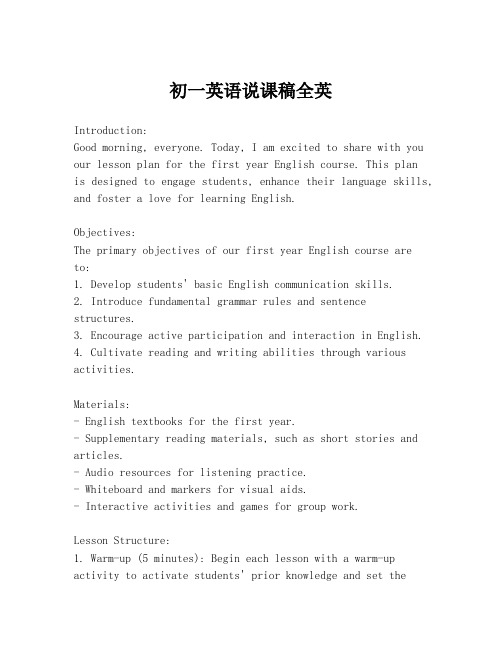
初一英语说课稿全英Introduction:Good morning, everyone. Today, I am excited to share with you our lesson plan for the first year English course. This planis designed to engage students, enhance their language skills, and foster a love for learning English.Objectives:The primary objectives of our first year English course are to:1. Develop students' basic English communication skills.2. Introduce fundamental grammar rules and sentence structures.3. Encourage active participation and interaction in English.4. Cultivate reading and writing abilities through various activities.Materials:- English textbooks for the first year.- Supplementary reading materials, such as short stories and articles.- Audio resources for listening practice.- Whiteboard and markers for visual aids.- Interactive activities and games for group work.Lesson Structure:1. Warm-up (5 minutes): Begin each lesson with a warm-up activity to activate students' prior knowledge and set thestage for the day's topic. This could include a quick vocabulary review or a short conversation starter.2. Presentation (15 minutes): Introduce new vocabulary, grammar points, or reading materials. Use the whiteboard to illustrate concepts and provide examples.3. Practice (20 minutes): Engage students in activities that allow them to practice the new language points. This could include pair work, group discussions, or role-plays.4. Production (15 minutes): Provide opportunities for students to use the language creatively. This could involve writing a short paragraph, creating a dialogue, or giving a presentation.5. Review and Homework (5 minutes): Summarize the key points of the lesson and assign homework that reinforces the day's learning.Assessment:Assessment will be ongoing and will include:- Class participation and engagement in activities.- Performance in quizzes and tests that cover vocabulary, grammar, and reading comprehension.- Completion and quality of homework assignments.Differentiation:Differentiation will be addressed by:- Offering extension activities for advanced students.- Providing additional support and resources for students whoneed extra help.- Encouraging peer-to-peer learning and collaboration.Conclusion:In conclusion, our first year English course aims to provide a solid foundation in English language skills while making learning an enjoyable and interactive experience. We look forward to a successful and enriching academic year with our students.Thank you for your attention, and I am ready to answer any questions you may have about the lesson plan.。
初中英语全英说课稿(优秀5篇)
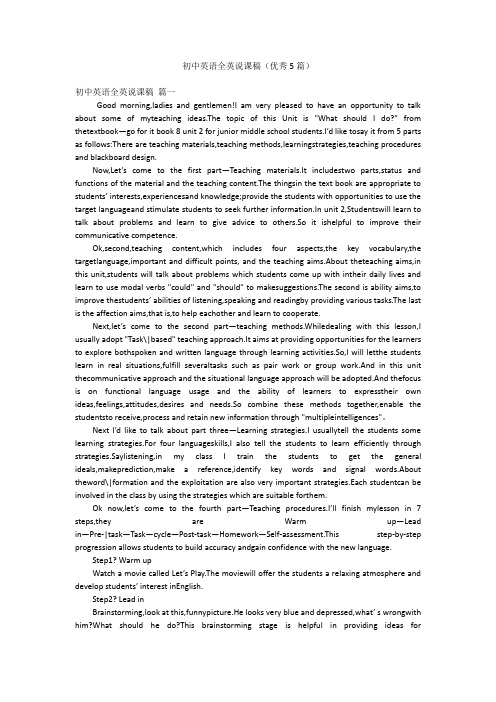
初中英语全英说课稿(优秀5篇)初中英语全英说课稿篇一Good morning,ladies and gentlemen!I am very pleased to have an opportunity to talk about some of myteaching ideas.The topic of this Unit is "What should I do?" from thetextbook—go for it book 8 unit 2 for junior middle school students.I’d like tosay it from 5 parts as follows:There are teaching materials,teaching methods,learningstrategies,teaching procedures and blackboard design.Now,Let’s come to the first part—Teaching materials.It includestwo parts,status and functions of the material and the teaching content.The thingsin the text book are appropriate to students’ interests,experiencesand knowledge;provide the students with opportunities to use the target languageand stimulate students to seek further information.In unit 2,Studentswill learn to talk about problems and learn to give advice to others.So it ishelpful to improve their communicative competence.Ok,second,teaching content,which includes four aspects,the key vocabulary,the targetlanguage,important and difficult points, and the teaching aims.About theteaching aims,in this unit,students will talk about problems which students come up with intheir daily lives and learn to use modal verbs "could" and "should" to makesuggestions.The second is ability aims,to improve thestudents’ abilities of listening,speaking and readingby providing various tasks.The last is the affection aims,that is,to help eachother and learn to cooperate.Next,let’s come to the second part—teaching methods.Whiledealing with this lesson,I usually adopt "Task\|based" teaching approach.It aims at providing opportunities for the learners to explore bothspoken and written language through learning activities.So,I will letthe students learn in real situations,fulfill severaltasks such as pair work or group work.And in this unit thecommunicative approach and the situational language approach will be adopted.And thefocus is on functional language usage and the ability of learners to expresstheir own ideas,feelings,attitudes,desires and needs.So combine these methods together,enable the studentsto receive,process and retain new information through "multipleintelligences"。
初中英语说课稿精选全英

初中英语说课稿精选全英Ladies and gentlemen,Today, I am excited to share with you a lesson plan that I have designed for a junior high school English class. This lesson is titled "Exploring the World of English Literature," and it is aimed at enhancing students' appreciation for English literature while improving their language skills.Objectives:1. To introduce students to various genres of English literature.2. To improve students' reading comprehension and vocabulary.3. To encourage students to express their thoughts and opinions in English.Materials:- Copies of selected English literature excerpts.- Whiteboard and markers.- Audio-visual equipment for playing literary adaptations.Warm-up Activity:We will begin the class with a brief discussion about the students' favorite books and authors. This will serve as an icebreaker and help gauge their familiarity with English literature.Introduction:I will introduce the concept of literature and its importance in our lives. We will discuss the different genres, such as poetry, prose, and drama, and their unique characteristics.Reading Comprehension:Students will be divided into small groups and given excerpts from various English literary works. They will read the excerpts silently, followed by a group discussion to answer comprehension questions and share their interpretations.Vocabulary Enhancement:We will identify and discuss new vocabulary words from the excerpts. Students will be encouraged to use these words in sentences to reinforce their understanding.Literary Analysis:Next, we will delve into the analysis of the selected literature. Students will learn about literary devices such as metaphor, simile, and personification, and how they are used in the texts.Creative Writing:To apply their learning, students will be asked to write a short paragraph inspired by one of the literary works they have read. This will help them practice using new vocabulary and literary techniques.Conclusion:We will conclude the lesson by sharing the creative writing pieces with the class. This will provide an opportunity for peer feedback and further discussion.Homework:For homework, students will be asked to choose a piece of English literature that interests them and write a brief summary and analysis, focusing on the use of language and literary devices.Assessment:The lesson will be assessed through group participation, the quality of the creative writing, and the homework assignment.I believe this lesson plan will not only improve students' English language skills but also ignite a passion for English literature. Thank you for your attention, and I look forward to implementing this lesson in the classroom.。
全英文初中英语说课稿范文
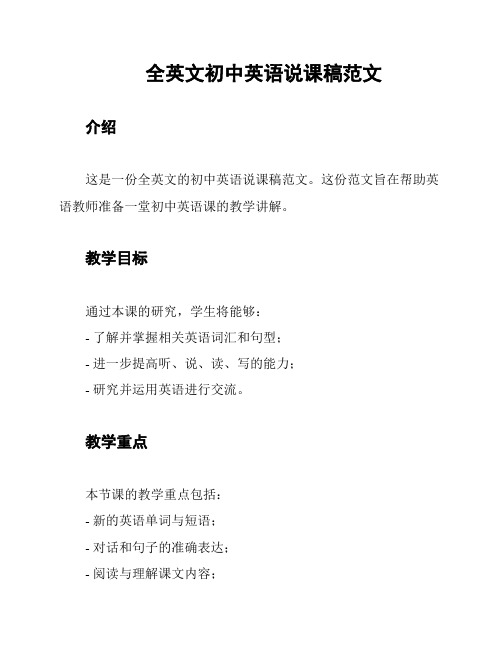
全英文初中英语说课稿范文介绍这是一份全英文的初中英语说课稿范文。
这份范文旨在帮助英语教师准备一堂初中英语课的教学讲解。
教学目标通过本课的研究,学生将能够:- 了解并掌握相关英语词汇和句型;- 进一步提高听、说、读、写的能力;- 研究并运用英语进行交流。
教学重点本节课的教学重点包括:- 新的英语单词与短语;- 对话和句子的准确表达;- 阅读与理解课文内容;- 口语表达和书写能力的提升。
教学准备在开始授课之前,教师需要准备以下教学材料:- PowerPoint幻灯片;- 学生课本和练册;- 黑板和白板擦;- 没有版权问题的相关图片。
教学过程第一阶段:导入 (5分钟)教师通过展示相关图片和用英语与学生进行简单的对话,激发学生的研究兴趣。
第二阶段:新知讲解 (15分钟)教师介绍本节课的新单词和短语,通过示范、解释并提供例句帮助学生理解和记忆。
第三阶段:对话练 (15分钟)教师与学生进行对话练,引导学生熟练运用新单词和短语,并纠正他们的发音和语法错误。
第四阶段:阅读理解 (15分钟)教师让学生阅读一篇相关短文,并提问相关问题,帮助学生理解课文内容并提高阅读理解能力。
第五阶段:口语表达 (15分钟)教师与学生进行口语对话训练,通过角色扮演和实际情境练提高学生的口语表达能力。
第六阶段:练与巩固 (10分钟)教师组织学生进行练和巩固活动,如填空题、选择题等,以检验学生对本节课内容的掌握程度。
第七阶段:作业布置 (5分钟)教师布置适当的课后作业,巩固学生对本节课内容的理解和运用。
教学评价教师可以通过观察学生在课堂上的表现、听写、口语交流等方式对学生的研究情况进行评价。
结束语通过本堂课的研究,相信学生们能够更好地掌握英语知识,提高自己的英语能力。
谢谢大家!以上是全英文初中英语说课稿范文的详细内容,希望对您有所帮助。
全英经典初中英语说课稿

(全英)经典初中英语说课稿Good afternoon, my dear judges, I am ———, from ————, it is my great honor to have this opportunity to talk about my teaching ideas. My presentation consists of five parts.Part 1 The analysis of the teaching materialThis lesson is a reading passage, which focused on the topic of __________________, such a topic is related to our daily life, so it is easy to arouse the Ss’ learning interests.My teaching objectives include the following parts.First, the knowledge objective :By the end of this lesson, Ss can learn the new words and new phrases:______________________________________ 其他参考活动:Debate----当话题有矛盾的双面Discussion——当话题是讨论解决问题Do a survey——调查Understand the main idea of the article;And master the usage of ___________________(某个语法点)Second, the Ability objective:skim for the main idea of the article andscan for the specific information,predict some information andunderstand the whole article, andenlarge the relative knowledge by reading more materials in library or from internet, write a report of the topic, etc. Third the emotional objective:to develop the spirit of cooperation through teamwork and pair-discussion;arouse Ss’ interest in English learningForth, the Cultural awarenessFifth the Important points:to get an overall understanding of the whole text,and develop their reading skills such as anticipating, skimming, scanning, summarizing language points…..…(具体课型用具体例子阐述)the usage of the______________________( 语法或句型)While the Difficult points:Are enable the Ss to use the new words and phrases to express their ideas in daily life, and develop the ability of skimming and scanning.master the usage of ____________________________( 语法或句型)根据教学过程设计的内容来决定)Part 2 The analysis of studentsThe Ss have learned English for some years. They understand some words and simple sentences. They are curious, active, and fond of game, competition, and various activities. They enjoy learning through cooperation in a relaxing atmosphere.Part 3 Teaching methodsIn this lesson, My teaching methods includeaudio-visual teaching method, communicative teaching method, and task-based teaching methods.Besides, a computer, blackboard, a tape recorder, a projector are needed as the teaching aids.Part 4 Teaching proceduresThere are five steps in my teaching procedures. But before teaching, I will divide the whole class into 4 groups to do competitions while finish different tasks in this lesson.Step 1 Warming-up and leading in (3mins)Free talk; talk something related the topic of the article.参考活动:Brainstorming, setting the scene, show pictures etc.Purpose: activate the Ss to regard the topic of ___________________(主题) and create a relaxing atmosphere. Step 2 Pre-reading (10mins)There are 3 tasks for the Ss.Do a guessing game.Show some funny pictures and sentences on PPT and then ask the Ss toGuess the meaning of the new words.Practice the new words and phrases:Match the new words and phrases with the Chinese meanings.Predicting: based on the title/ pictures on the text. ( 看具体情况而定)Purpose: through guessing, to arouse Ss learning interest, and help them to learn the new words and phrases which they may come across while reading, pave the way for the following learning and cultivate the ability of anticipating.{Meanwhi le, pronunciation of some letter strings such as “ea” (pea, tea, feast..) and “er” (cucumber…) are highlighted so as to foster students’ phonetic sensitivity.} (如果有语音教学则可渗透。
初中英语面试全英说课稿
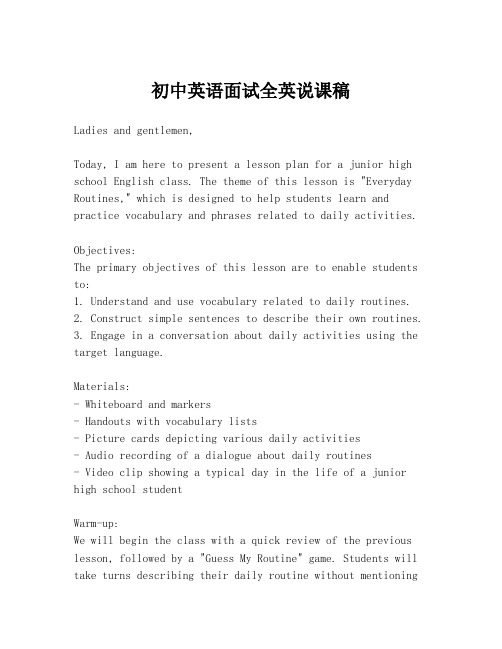
初中英语面试全英说课稿Ladies and gentlemen,Today, I am here to present a lesson plan for a junior high school English class. The theme of this lesson is "Everyday Routines," which is designed to help students learn and practice vocabulary and phrases related to daily activities.Objectives:The primary objectives of this lesson are to enable students to:1. Understand and use vocabulary related to daily routines.2. Construct simple sentences to describe their own routines.3. Engage in a conversation about daily activities using the target language.Materials:- Whiteboard and markers- Handouts with vocabulary lists- Picture cards depicting various daily activities- Audio recording of a dialogue about daily routines- Video clip showing a typical day in the life of a junior high school studentWarm-up:We will begin the class with a quick review of the previous lesson, followed by a "Guess My Routine" game. Students will take turns describing their daily routine without mentioningtheir own name, and the class will try to guess who is being described.Vocabulary Introduction:Next, I will introduce the key vocabulary words for this lesson, such as "wake up," "brush teeth," "have breakfast," "go to school," "do homework," "watch TV," "go to bed," etc. Students will repeat these words after me and write them down in their notebooks.Practice:Students will then work in pairs to match the vocabulary words with picture cards. Afterward, they will create sentences using these words to describe a typical day.Listening Activity:We will listen to an audio recording of a dialogue between two students discussing their daily routines. Students will follow along with the script provided and underline any new vocabulary they encounter.Speaking Activity:In groups of three or four, students will create their own dialogues based on the audio recording. They will practice their dialogues and then perform them in front of the class.Reading Comprehension:Students will read a short passage about the importance of maintaining a healthy daily routine. They will answer comprehension questions to check their understanding.Wrap-up:To conclude the lesson, we will watch a video clip that shows a day in the life of a junior high school student. Students will discuss what they observed and how it compares to their own routines.Homework:For homework, students will write a short paragraph describing their ideal daily routine, incorporating as many of the vocabulary words as possible.This lesson plan is designed to be interactive and engaging, allowing students to practice their English skills in a meaningful context. Thank you for your attention, and I look forward to implementing this lesson in the classroom.。
初中英语说课稿全英

初中英语说课稿全英Ladies and Gentlemen,Today, I am here to present a lesson plan for a junior high school English class. The topic of our lesson is "The Importance of Communication Skills". This lesson is designed to be interactive and engaging, aiming to help students understand the significance of effective communication in their daily lives and to develop their English speaking abilities.Objectives:1. To enable students to recognize the importance of communication skills.2. To improve students' English vocabulary related to communication.3. To practice listening and speaking skills through various activities.Materials:- Whiteboard and markers- Handouts with vocabulary and phrases- Audio recording of a conversation- Video clips demonstrating effective communication- Role-play scenariosIntroduction (5 minutes):Begin the class with a thought-provoking question: "Can youimagine a world without communication?" Allow students to share their thoughts briefly to set the context for the lesson.Vocabulary Building (10 minutes):Distribute handouts containing key vocabulary words such as 'articulate', 'persuasive', 'empathetic', and 'non-verbal cues'. Explain the meanings and encourage students to use these words in sentences.Listening Practice (15 minutes):Play an audio recording of a conversation where effective communication is demonstrated. After listening, ask students to identify the communication skills used by the speakers.Speaking Practice (20 minutes):Divide the class into small groups and assign each group a role-play scenario that requires effective communication. For example, negotiating a peace treaty, resolving a conflict, or persuading someone to join a club. Encourage students to use the vocabulary they learned earlier.Video Analysis (10 minutes):Show a video clip of a public speaker or a scene from a movie where communication skills are crucial. Discuss the techniques used by the speaker or characters and how they contribute to the effectiveness of the communication.Debate Activity (15 minutes):Organize a debate on a relevant topic, such as "Is face-to-face communication better than digital communication?". Thiswill allow students to apply their communication skills in a structured setting.Conclusion (5 minutes):Summarize the key points of the lesson and emphasize the importance of communication skills in personal and professional contexts. Encourage students to reflect on how they can improve their own communication abilities.Homework:Ask students to write a short essay on the role of communication in their lives, using the vocabulary and concepts covered in the lesson.This lesson plan is designed to be dynamic and student-centered, ensuring that students not only understand the theoretical aspects of communication but also have the opportunity to practice and apply these skills in a variety of contexts. Thank you for your attention.。
全英文初中英语说课稿_说课稿

全英文初中英语说课稿_说课稿Title: Full English Speaking Course for Junior Middle School Students_Speaking OutlineIntroduction:In this speaking outline, I will present a comprehensive English speaking course for junior middle school students. The course is designed to enhance students' oral communication skills, including pronunciation, vocabulary usage, and fluency. Through interactive activities and engaging materials, students will have the opportunity to practice and improve their speaking abilities.1. Warm-up Activity:The warm-up activity aims to create a positive learning atmosphere and activate students' prior knowledge. The teacher can start by asking students questions related to everyday topics such as hobbies, sports, or favorite movies. This will encourage students to express their opinions and contribute to classroom discussions.2. Pronunciation Practice:Effective pronunciation is crucial for clear and accurate communication. The teacher can introduce various phonetic sounds and demonstrate how to articulate them correctly. Engaging activities like tongue twisters or role-playing dialogues can be used to help students practice and improve their pronunciation skills.3. Vocabulary Expansion:Enriching students' vocabulary is essential for effective communication. The teacher can introduce new words and phrases using real-life situations and vivid examples. Interactive games, vocabulary quizzes, or multimedia resources can be utilized to make the learning process more enjoyable and memorable.4. Speaking Activities:To develop students' speaking abilities, it is vital to provide ample opportunities for them to practice in class. The teacher can design speaking activities such as pair work, group discussions, or debates on topics of interest to the students. By encouraging students to express their thoughts and opinions, their confidence in speaking English will gradually improve.5. Role-Play:Role-play activities not only enhance students' speaking skills but also promote critical thinking and problem-solving abilities. The teacher can assign different roles to students and present various scenarios or simulations, such as ordering food in a restaurant or conducting a job interview. This will encourage students to use English in realistic contexts and develop their communication skills.6. Multimedia Resources:Utilizing multimedia resources like videos, podcasts, or online platforms can make the English speaking course more interactive and engaging. The teacher can incorporate these resources into lessons to provide authentic and diverse language input, facilitating students' understanding and expression of English.7. Assessment:Regular assessment is necessary to monitor students' progress and provide feedback for improvement. The teacher can conduct individual or group presentations, role-plays, or oral exams to evaluate students' speaking abilities. Constructive feedback should be given to help students identify their strengths and areas for improvement.Conclusion:This comprehensive English speaking course for junior middle school students aims to enhance students' oral communication skills through various engaging activities and resources. By providing a supportive and interactive learning environment, students will develop confidence, fluency, and accuracy in speaking English. Through consistent practice and guidance, students' speaking abilities will significantly improve, enabling them to effectively communicate in real-life situations.。
初中英语全英说课稿优秀8篇
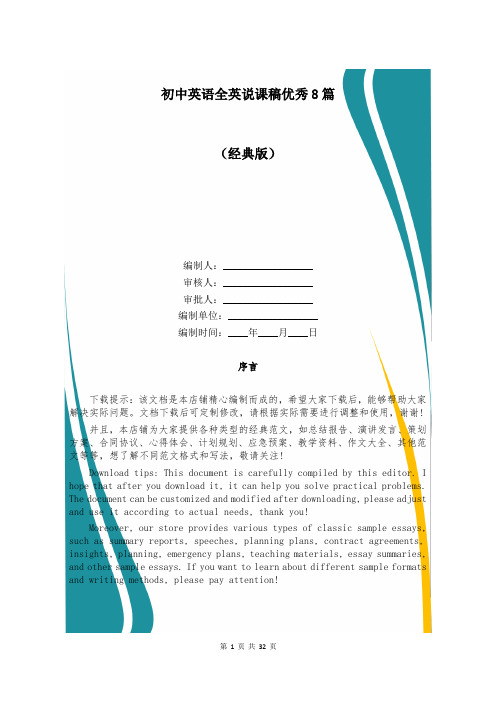
初中英语全英说课稿优秀8篇(经典版)编制人:__________________审核人:__________________审批人:__________________编制单位:__________________编制时间:____年____月____日序言下载提示:该文档是本店铺精心编制而成的,希望大家下载后,能够帮助大家解决实际问题。
文档下载后可定制修改,请根据实际需要进行调整和使用,谢谢!并且,本店铺为大家提供各种类型的经典范文,如总结报告、演讲发言、策划方案、合同协议、心得体会、计划规划、应急预案、教学资料、作文大全、其他范文等等,想了解不同范文格式和写法,敬请关注!Download tips: This document is carefully compiled by this editor. I hope that after you download it, it can help you solve practical problems. The document can be customized and modified after downloading, please adjust and use it according to actual needs, thank you!Moreover, our store provides various types of classic sample essays, such as summary reports, speeches, planning plans, contract agreements, insights, planning, emergency plans, teaching materials, essay summaries, and other sample essays. If you want to learn about different sample formats and writing methods, please pay attention!初中英语全英说课稿优秀8篇说课活动分课前说课和课后说课两种形式,不论是课前说课还是课后说课上述内容必须阐述清楚。
初中英语全英优秀说课稿模板范文

初中英语全英优秀说课稿模板范文尊敬的评委老师、各位同仁:大家好!今天,我将为大家展示一节初中英语课程的说课稿。
本节课的主题是“环境保护”,这是一节以提高学生环境保护意识为目标的听说课。
接下来,我将从教学目标、教学内容、教学方法、教学过程以及评价与反思五个方面进行详细介绍。
一、教学目标本节课的教学目标分为知识目标、能力目标和情感态度价值观目标三个层面。
1. 知识目标:学生能够掌握与环境保护相关的基本词汇和表达,如“pollution”, “recycle”, “conservation”等,并能够运用这些词汇和表达进行简单的对话和讨论。
2. 能力目标:通过本节课的学习,学生能够提高英语听说能力,能够在实际情境中运用所学语言知识进行交流,并能够进行简单的英语口头报告。
3. 情感态度价值观目标:培养学生的环境保护意识,激发学生参与环境保护活动的兴趣和热情,引导学生形成保护环境的良好习惯。
二、教学内容本节课的教学内容包括以下几个部分:1. 热身活动:通过图片和视频引入环境保护的话题,激发学生的兴趣。
2. 新词汇和表达的学习:通过图片、实物和情景对话等方式,教授与环境保护相关的词汇和表达。
3. 听力练习:播放一段关于环境保护的英语视频,让学生听后回答问题,检验学生对新词汇和表达的掌握情况。
4. 口语练习:分组进行情景对话练习,模拟环保活动的策划和讨论。
5. 口头报告:每组选出一名代表,就本组讨论的环保活动进行简短的口头报告。
三、教学方法为了提高教学效果,本节课将采用以下教学方法:1. 任务型教学法:通过设计贴近学生生活的任务,让学生在完成任务的过程中学习和使用英语。
2. 合作学习:鼓励学生分组合作,通过交流和讨论,共同完成任务。
3. 多媒体教学:利用图片、视频等多媒体教学资源,增加课堂的趣味性和直观性。
四、教学过程本节课的教学过程安排如下:1. 热身活动(5分钟)通过展示环境污染的图片和视频,引导学生谈论自己对环境保护的看法,为后续学习做好铺垫。
初中英语全英说课稿

初中英语全英说课稿一、教材分析本次说课的教材是《初中英语》(外研版)七年级上册第三单元,主要内容是关于日常活动的表达。
该单元通过日常活动的描述和问答,培养学生运用英语进行日常交流的能力。
二、教学目标1. 知识目标本单元的知识目标主要包括以下方面:- 掌握日常活动的词汇和表达方式;- 理解和运用现在进行时态进行日常活动的描述;- 能够进行日常活动的问答。
2. 能力目标通过本单元的研究,学生将培养以下能力:- 能够准确使用英语进行日常活动的描述和问答;- 提高听、说、读、写的综合能力;- 培养良好的研究惯和团队合作精神。
3. 情感目标通过本单元的研究,学生将培养以下情感目标:- 养成积极参与英语研究的态度;- 培养对不同文化的尊重和理解;- 提高自信心和自主研究能力。
三、教学重点- 日常活动的词汇和表达方式;- 现在进行时态的运用;- 日常活动的问答。
四、教学过程本单元的教学过程分为以下几个环节:1. 导入(5分钟)通过展示图片和简短对话的方式引入本单元的研究内容,激发学生的研究兴趣。
2. 研究新知(20分钟)通过教师的示范、学生的模仿和合作讨论,引导学生研究本单元的新知识,包括日常活动的词汇和表达方式。
3. 练巩固(15分钟)通过个人、小组和全班的练方式,提供多样化的练任务,巩固学生对所学知识的掌握程度。
4. 拓展延伸(10分钟)通过听力、口语和阅读等多种形式的任务,拓展学生对本单元知识的运用能力和理解深度。
5. 小结归纳(5分钟)通过学生回答问题和讨论,对本节课的重点知识进行小结和归纳,梳理并巩固学生的研究成果。
五、教学资源- 课本《初中英语》(外研版)七年级上册;- 多媒体设备;- 图片、图片卡片;- 实物或模型。
六、教学评估通过课堂练、听说读写任务和个人评价等形式,对学生的研究情况进行评估和反馈。
同时,鼓励学生相互合作和互相帮助,培养积极向上的研究氛围。
七、板书设计初中英语全英说课稿教材分析教学目标- 知识目标- 能力目标- 情感目标教学重点教学过程教学资源教学评估板书设计八、教学反思通过本节课的教学,学生能够逐渐掌握日常活动的词汇和表达方式,并能够进行相关问答。
初中英语说课稿全英面试

初中英语说课稿全英面试Ladies and Gentlemen,Today, I am honored to be here to share with you my lesson plan for a middle school English class. The topic of my lesson is "Exploring the World of Animals," which is designed to engage students in learning English through the context of animals and their habitats.Objectives:The primary objectives of this lesson are to:1. Enable students to understand and use new vocabulary related to animals and their habitats.2. Improve students' listening and speaking skills by engaging them in a dialogue about animals.3. Encourage students to express their opinions and thoughts about animal conservation.Materials:- A set of pictures depicting various animals and their habitats.- Audio recordings of animal sounds.- A video clip showing animals in their natural environments. - Handouts with vocabulary and dialogues.Procedure:1. Warm-up (5 minutes):Begin the class with a quick review of previously learned animal vocabulary. Use flashcards or a PowerPoint presentation to elicit responses from the students.2. Introduction (10 minutes):Show the class a series of pictures of animals and their habitats. Introduce new vocabulary and write it on the board. Encourage students to repeat the words after you.3. Listening Activity (15 minutes):Play the audio recordings of different animal sounds. Ask students to identify the animals based on the sounds. This activity will enhance their listening skills and reinforce the new vocabulary.4. Speaking Activity (20 minutes):In pairs or small groups, students will engage in a role-play activity where they describe an animal and its habitat using the vocabulary they have learned. This will help them practice speaking English in a structured and meaningful way.5. Video Viewing (10 minutes):Show a video clip of animals in their natural habitats. After watching, initiate a class discussion about the importance of conservation and the role humans play in protecting wildlife.6. Debate (15 minutes):Divide the class into two groups. One group will argue for the protection of a specific animal species, while the other group will argue against it. This will encourage criticalthinking and the use of persuasive language.7. Reflection and Homework (5 minutes):End the lesson by asking students to reflect on what they have learned and to consider their own attitudes towards animal conservation. For homework, students will write a short paragraph about their favorite animal and why theythink it is important to protect it.Assessment:The assessment will be based on the students' participationin the activities, their ability to use the new vocabulary correctly, and the quality of their homework assignment.Conclusion:This lesson aims to make learning English fun and relevant by connecting it to the real world. It also seeks to instill a sense of responsibility towards the environment and its inhabitants.Thank you for your attention, and I look forward to any questions or feedback you may have.。
全英初中英语说课稿

全英初中英语说课稿尊敬的同事们,大家好!今天,我将与大家分享一份针对全英初中英语课程的说课稿。
这份说课稿旨在阐述我们的教学目标、教学内容、教学方法以及评估方式,以确保我们的学生能够在英语学习上取得最佳成果。
一、教学目标在全英教学环境下,我们的目标是培养学生的英语听说读写能力,使他们能够在日常生活和学术领域中自如地使用英语。
此外,我们还希望通过本课程,增强学生的跨文化交流意识和能力,为他们将来在全球化背景下的学习和工作打下坚实的基础。
二、教学内容本课程的教学内容围绕以下几个核心模块展开:1. 语言技能:我们将重点训练学生的听、说、读、写四项基本语言技能,通过各种活动和练习,提高学生的语言运用能力。
2. 文化知识:介绍英语国家的文化背景,包括历史、文学、艺术、社会习俗等,帮助学生更好地理解语言背后的文化内涵。
3. 学习策略:教授有效的英语学习策略,如记忆技巧、阅读技巧、写作框架等,帮助学生提高学习效率。
4. 情景对话:通过模拟真实生活场景的对话练习,让学生在实际交流中运用所学语言,提高口语交际能力。
5. 项目作业:设计各种项目作业,鼓励学生团队合作,运用英语解决实际问题,培养他们的创新思维和团队协作能力。
三、教学方法为了实现上述教学目标,我们将采用以下教学方法:1. 互动式教学:通过小组讨论、角色扮演、辩论等活动,激发学生的参与热情,提高他们的英语交流能力。
2. 任务型教学:设计贴近学生生活和兴趣的任务,让学生在完成任务的过程中自然地学习和使用英语。
3. 多媒体辅助:利用视频、音频、图片等多种媒体资源,丰富教学内容,提高学生的学习兴趣。
4. 个性化指导:针对学生的不同水平和需求,提供个性化的辅导和支持,帮助每个学生都能取得进步。
四、评估方式为了全面了解学生的学习情况,我们将采用以下评估方式:1. 形成性评估:通过课堂表现、作业完成情况、小组项目等,持续跟踪学生的学习进展。
2. 综合性评估:定期进行听说读写的综合测试,评估学生的语言技能水平。
完整版)初中英语说课稿全英文版
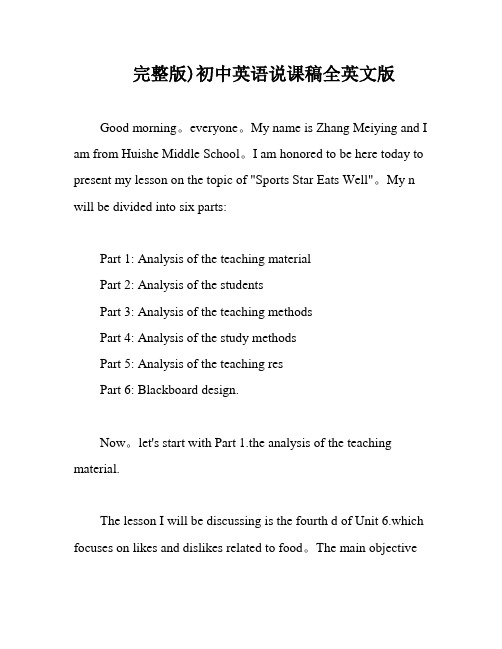
完整版)初中英语说课稿全英文版Good morning。
everyone。
My name is Zhang Meiying and I am from Huishe Middle School。
I am honored to be here today to present my lesson on the topic of "Sports Star Eats Well"。
My n will be divided into six parts:Part 1: Analysis of the teaching materialPart 2: Analysis of the studentsPart 3: Analysis of the teaching methodsPart 4: Analysis of the study methodsPart 5: Analysis of the teaching resPart 6: Blackboard design.Now。
let's start with Part 1.the analysis of the teaching material.The lesson I will be discussing is the fourth d of Unit 6.which focuses on likes and dislikes related to food。
The main objectiveof this lesson is to teach students about the importance of healthy eating habits for sports stars。
To achieve this objective。
we will analyze the following aspects:1.Status and n: The lesson is an integral part of the curriculum and plays a significant role in helping students understand the importance of healthy eating habits for athletes.Let's move on to Part 2.the analysis of the students.Teaching aims and demands include knowledge aims。
- 1、下载文档前请自行甄别文档内容的完整性,平台不提供额外的编辑、内容补充、找答案等附加服务。
- 2、"仅部分预览"的文档,不可在线预览部分如存在完整性等问题,可反馈申请退款(可完整预览的文档不适用该条件!)。
- 3、如文档侵犯您的权益,请联系客服反馈,我们会尽快为您处理(人工客服工作时间:9:00-18:30)。
3.Moral objects
(1) To enable the Ss to be polite and love life.
(2) To enable the Ss to look after their things well.
(四)TEACHING KEY AND DIFFICULT POINTS
each other. (2).To enable the Students to study in groups
and co-operate skillfully. (3).To develop the Students’ interest in English. 2.Difficult points: (1) How to make dialogues and act them out. (2) How to write the right whole sentences.
全英初中英语说课
Part One Analysis of the
Teaching Material
(一) STATUS AND FUNCTION
1.This is an important lesson in Book One. From this lesson, it starts asking the Ss to grasp contents of each Sample. To attain “four skills” request of listening,ng. Therefore this lesson is in the important position of the teaching material.
.
(三)TEACHING AIMS AND DEMANDS
(1) To make the students know how to use the affirmative sentence “This is. . . .” and the negative sentence “This is not….”Everyday expressions for “Apologies”“I\'m sorry”“That\'s all right”. (2) To study the new words “six, hey, sorry, it’s, that’s”, etc. by learning the dialogue of this lesson. (3) To finish some exercises. 2.Ability objects (1) To develop the students’ abilities of listening, speaking, reading and writing. (2) To train the Ss’ ability of working in pairs and communication by learning the useful structures
English in the Middle School is to cultivate students’ abilities of listening, speaking, reading, writing and their good sense of the English language. So in this lesson I’ll mainly use “Communicative” teaching method, “Audio-visual” teaching method and “Task-based” teaching method. That is to say, I’ll let the Ss to get a better understanding of the key structure of the dialogue. I’ll give the Ss some tasks and arrange five kinds of activities: talking, guessing games, watching CAI, acting out Sample A and having a competition. Teaching special features To use these methods are helpful to develop the Ss’ thought
Part Two The Teaching Methods
1. Communicative teaching method 2. Audio-visual teaching method 3. Task-based” teaching method As we all know: the main instructional aims of learning
(五) TEACHING AIDS
Multi-media computer, Tape recorder, Software: Powerpoint or Authorware, school things and so on. They will be needed in this lesson
2.This lesson is the first one of Unit 2.So if the Ss can learn it well, it will be helpful to make the Ss learn the rest of this unit.
(二)ANALYSIS OF THE STUDENTS
The students has learned English for about one month so far. They can understand some words and some simple sentences. The stdents have taken a great interest in English now
The teaching key and difficult points’ basis is established according to Sample A of Lesson Six in the teaching material\'s position and function.
1.Key points: (1).To help the Students to communicate with
